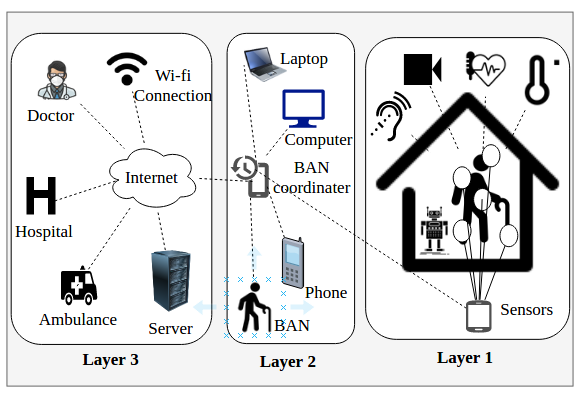
With the advancement of medical science, the average longevity of humans is increasing day-by-day resulting in more elderly populations in many countries. This trend demands new ways of medical care that act proactively rather than being reactive. Currently, treatment is provided to handle emergencies. However, with the more elderly population, day-to-day monitoring is needed for early detection of any anomaly in vital signs. Rather, the living environment at home can be made smart enough to monitor and detect any vital signs and communicate them to the proper place, like a nursing center or the hospital. As mentioned by Wang “ Ambient Assisted Living (AAL) enhances the independent living ability of the elderly through various intelligent services, reducing the need for direct care giving, indoors or outdoors”. The use of wireless technology, in particular medical applications of wireless sensor networks and wireless body area networks in ALL, improves the existing health-care and monitoring services especially for the elderly and chronically ill.
A typical ALL system consists of diverse technologies and systems incorporating Medical Sensors, Wireless Sensor and Actuator Networks (WSANs), RFID tags and readers, computer systems, computer networks, software applications, and databases, which are interconnected to exchange data and provide services in an Ambient Assisted Environment (AAE).
Wireless communication serves as a key enabling technology to support connectivity among different components of the system including, medical sensors, ambient sensors, home gateways, and wireless routers that enable the logging/monitoring applications to report data in soft real-time to health-care professionals. Most of the existing solutions include one or more types of sensors carried by the patient, forming a Body Area Network (BAN), and one or more types of sensors carried by types of sensors deployed in the environment forming a Personal Area Network (PAN). These two are connected to a backbone network via a gateway node.
In ALL systems comprising BAN and PAN sub-components, one of the most precious resources is energy. Since sensor nodes rely on battery power and can only operate as long as their batteries maintain power, their hardware system, for example, micro-controller and radio communication subsystems should be designed for low power consumption.
An example architecture of the AAL system is shown in Figure 1.
As can be seen, the BAN constitutes layer-1 where body sensors communicate directly or indirectly to the BAN coordinator. In layer-2, information is received from the BAN coordinator to the local access point or a home gateway, smart devices acting as a gateway of a simple workstation that is connected to the Internet. The information received by any layer-2 device is finally transmitted to layer-3 via the Internet or cellular network. Such a system can operate in a centralized or distributed fashion. Wearable sensors carried by a person constitute a BAN configuration consisting of a BAN coordinator and multiple sensors like the one showed in Figure 1.
